Performance Management Strategies for Employee Retention: A Report
VerifiedAdded on 2023/05/30
|12
|2916
|191
Report
AI Summary
This report delves into the critical aspects of performance management, addressing its current challenges and offering potential solutions. It begins by outlining the problems associated with traditional performance management systems, such as time consumption, subjectivity, and demotivation, and emphasizes the need for a more effective approach. The report examines the importance of labor market analysis, recruitment, and succession planning, highlighting how these factors influence employee retention and organizational success. It also explores various strategies for employee retention, including the integration of high-performance management and corporate social responsibility. The report then analyzes a case study of companies and discusses factors related to performance management and the issues surrounding it. The report concludes by emphasizing the importance of adapting performance management strategies to align with the evolving needs of the modern workforce. The focus is on strategies to foster a collaborative atmosphere, align metrics for success, and leverage employee data effectively.

REPORT
Paraphrase This Document
Need a fresh take? Get an instant paraphrase of this document with our AI Paraphraser
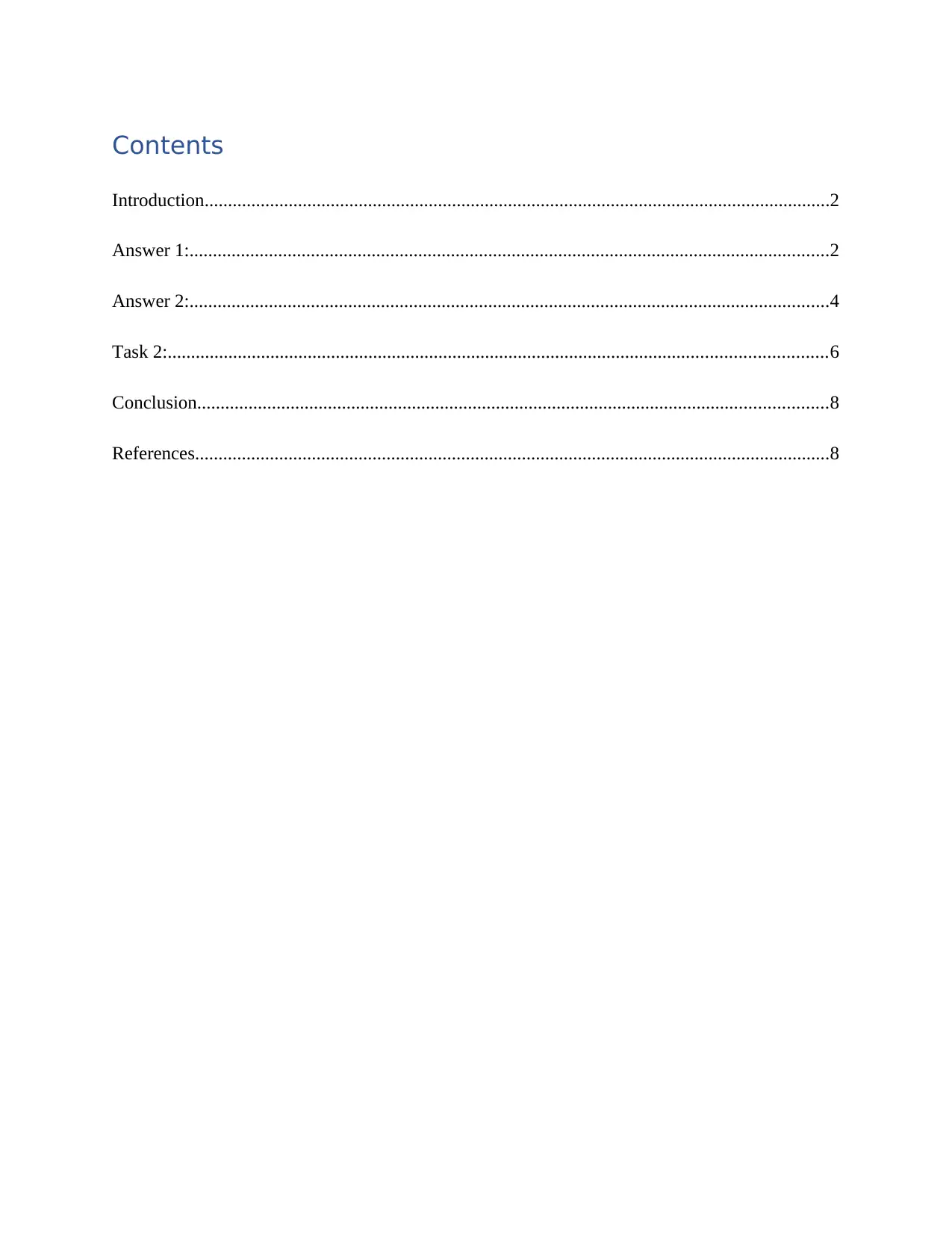
Contents
Introduction......................................................................................................................................2
Answer 1:.........................................................................................................................................2
Answer 2:.........................................................................................................................................4
Task 2:.............................................................................................................................................6
Conclusion.......................................................................................................................................8
References........................................................................................................................................8
Introduction......................................................................................................................................2
Answer 1:.........................................................................................................................................2
Answer 2:.........................................................................................................................................4
Task 2:.............................................................................................................................................6
Conclusion.......................................................................................................................................8
References........................................................................................................................................8
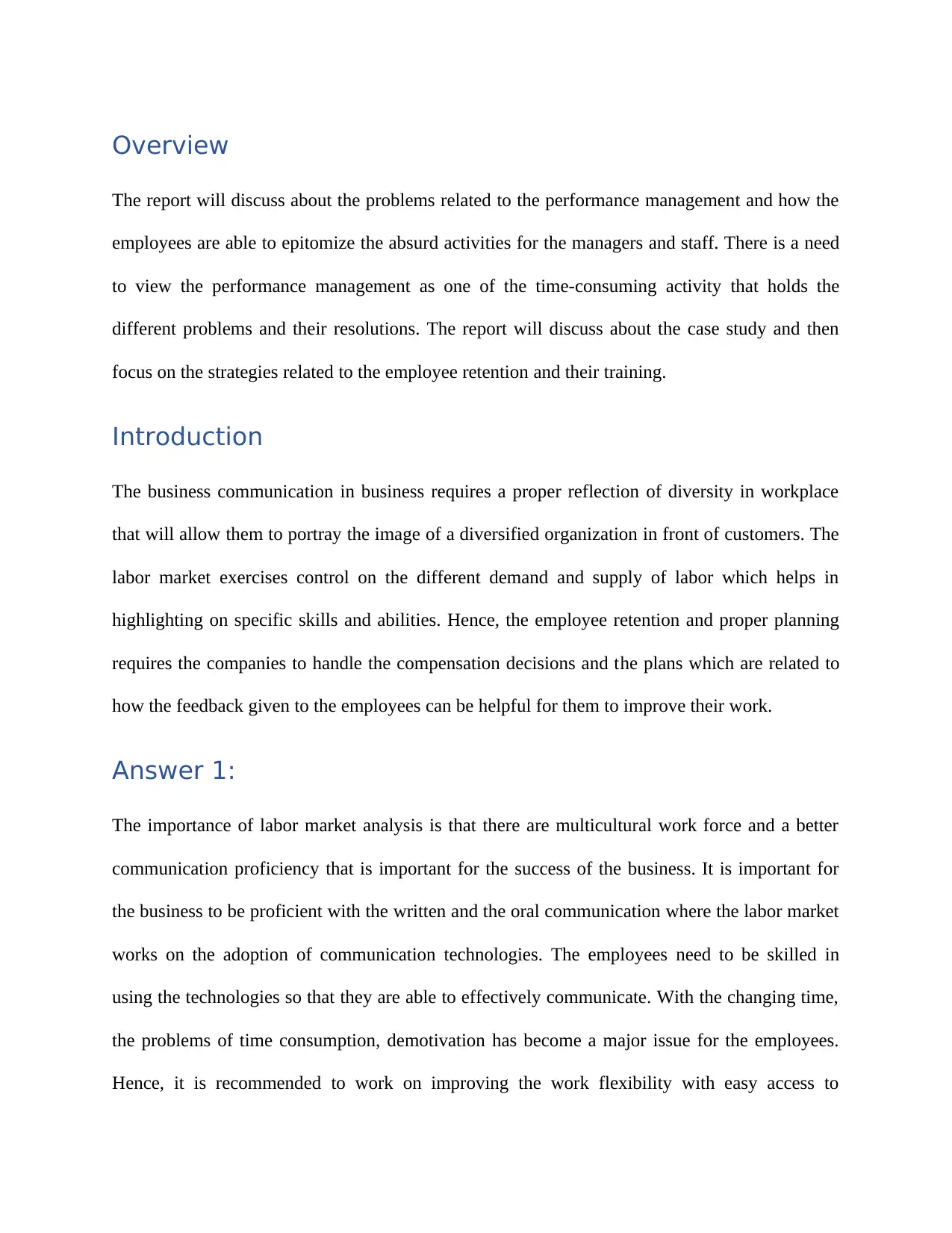
Overview
The report will discuss about the problems related to the performance management and how the
employees are able to epitomize the absurd activities for the managers and staff. There is a need
to view the performance management as one of the time-consuming activity that holds the
different problems and their resolutions. The report will discuss about the case study and then
focus on the strategies related to the employee retention and their training.
Introduction
The business communication in business requires a proper reflection of diversity in workplace
that will allow them to portray the image of a diversified organization in front of customers. The
labor market exercises control on the different demand and supply of labor which helps in
highlighting on specific skills and abilities. Hence, the employee retention and proper planning
requires the companies to handle the compensation decisions and the plans which are related to
how the feedback given to the employees can be helpful for them to improve their work.
Answer 1:
The importance of labor market analysis is that there are multicultural work force and a better
communication proficiency that is important for the success of the business. It is important for
the business to be proficient with the written and the oral communication where the labor market
works on the adoption of communication technologies. The employees need to be skilled in
using the technologies so that they are able to effectively communicate. With the changing time,
the problems of time consumption, demotivation has become a major issue for the employees.
Hence, it is recommended to work on improving the work flexibility with easy access to
The report will discuss about the problems related to the performance management and how the
employees are able to epitomize the absurd activities for the managers and staff. There is a need
to view the performance management as one of the time-consuming activity that holds the
different problems and their resolutions. The report will discuss about the case study and then
focus on the strategies related to the employee retention and their training.
Introduction
The business communication in business requires a proper reflection of diversity in workplace
that will allow them to portray the image of a diversified organization in front of customers. The
labor market exercises control on the different demand and supply of labor which helps in
highlighting on specific skills and abilities. Hence, the employee retention and proper planning
requires the companies to handle the compensation decisions and the plans which are related to
how the feedback given to the employees can be helpful for them to improve their work.
Answer 1:
The importance of labor market analysis is that there are multicultural work force and a better
communication proficiency that is important for the success of the business. It is important for
the business to be proficient with the written and the oral communication where the labor market
works on the adoption of communication technologies. The employees need to be skilled in
using the technologies so that they are able to effectively communicate. With the changing time,
the problems of time consumption, demotivation has become a major issue for the employees.
Hence, it is recommended to work on improving the work flexibility with easy access to
⊘ This is a preview!⊘
Do you want full access?
Subscribe today to unlock all pages.

Trusted by 1+ million students worldwide
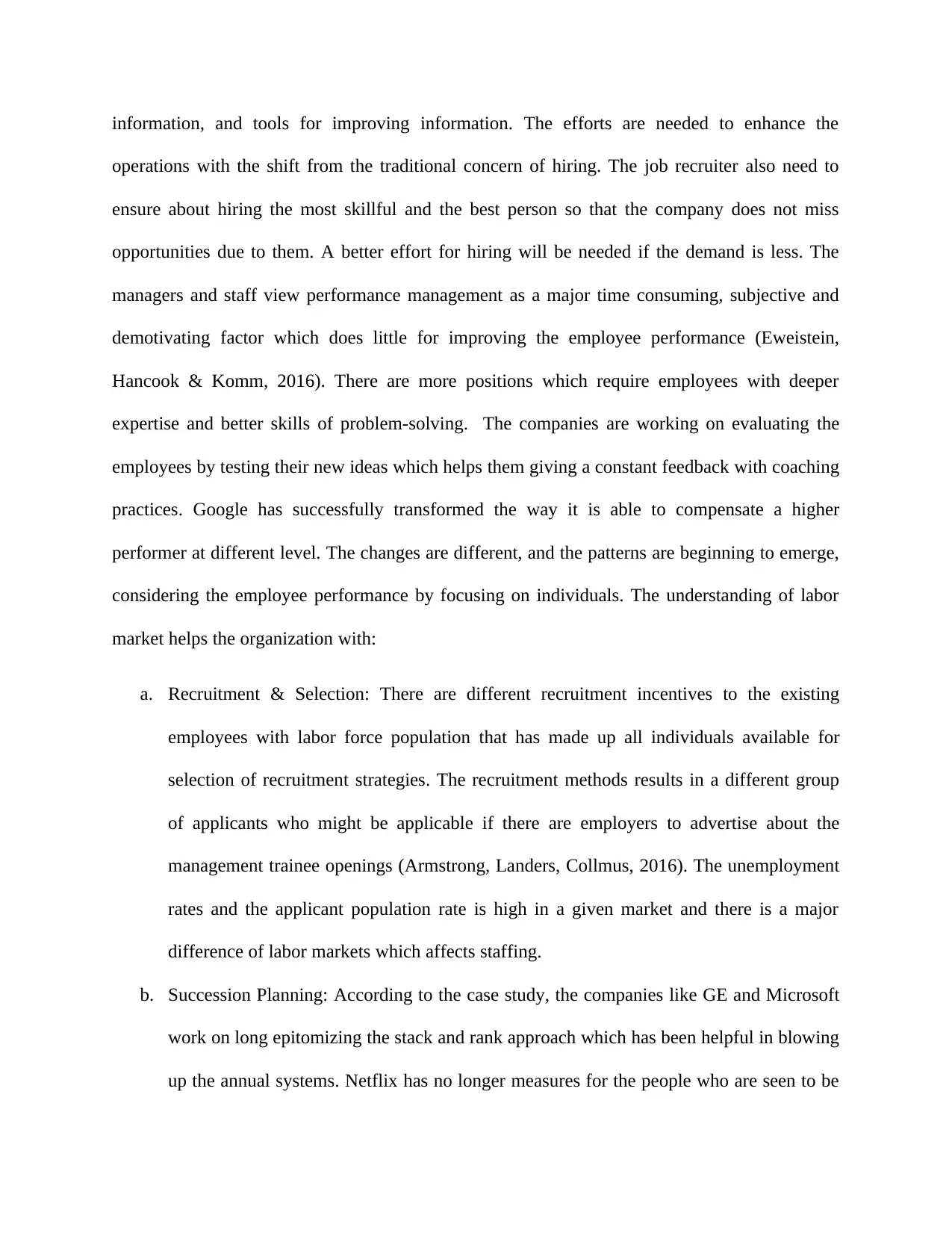
information, and tools for improving information. The efforts are needed to enhance the
operations with the shift from the traditional concern of hiring. The job recruiter also need to
ensure about hiring the most skillful and the best person so that the company does not miss
opportunities due to them. A better effort for hiring will be needed if the demand is less. The
managers and staff view performance management as a major time consuming, subjective and
demotivating factor which does little for improving the employee performance (Eweistein,
Hancook & Komm, 2016). There are more positions which require employees with deeper
expertise and better skills of problem-solving. The companies are working on evaluating the
employees by testing their new ideas which helps them giving a constant feedback with coaching
practices. Google has successfully transformed the way it is able to compensate a higher
performer at different level. The changes are different, and the patterns are beginning to emerge,
considering the employee performance by focusing on individuals. The understanding of labor
market helps the organization with:
a. Recruitment & Selection: There are different recruitment incentives to the existing
employees with labor force population that has made up all individuals available for
selection of recruitment strategies. The recruitment methods results in a different group
of applicants who might be applicable if there are employers to advertise about the
management trainee openings (Armstrong, Landers, Collmus, 2016). The unemployment
rates and the applicant population rate is high in a given market and there is a major
difference of labor markets which affects staffing.
b. Succession Planning: According to the case study, the companies like GE and Microsoft
work on long epitomizing the stack and rank approach which has been helpful in blowing
up the annual systems. Netflix has no longer measures for the people who are seen to be
operations with the shift from the traditional concern of hiring. The job recruiter also need to
ensure about hiring the most skillful and the best person so that the company does not miss
opportunities due to them. A better effort for hiring will be needed if the demand is less. The
managers and staff view performance management as a major time consuming, subjective and
demotivating factor which does little for improving the employee performance (Eweistein,
Hancook & Komm, 2016). There are more positions which require employees with deeper
expertise and better skills of problem-solving. The companies are working on evaluating the
employees by testing their new ideas which helps them giving a constant feedback with coaching
practices. Google has successfully transformed the way it is able to compensate a higher
performer at different level. The changes are different, and the patterns are beginning to emerge,
considering the employee performance by focusing on individuals. The understanding of labor
market helps the organization with:
a. Recruitment & Selection: There are different recruitment incentives to the existing
employees with labor force population that has made up all individuals available for
selection of recruitment strategies. The recruitment methods results in a different group
of applicants who might be applicable if there are employers to advertise about the
management trainee openings (Armstrong, Landers, Collmus, 2016). The unemployment
rates and the applicant population rate is high in a given market and there is a major
difference of labor markets which affects staffing.
b. Succession Planning: According to the case study, the companies like GE and Microsoft
work on long epitomizing the stack and rank approach which has been helpful in blowing
up the annual systems. Netflix has no longer measures for the people who are seen to be
Paraphrase This Document
Need a fresh take? Get an instant paraphrase of this document with our AI Paraphraser
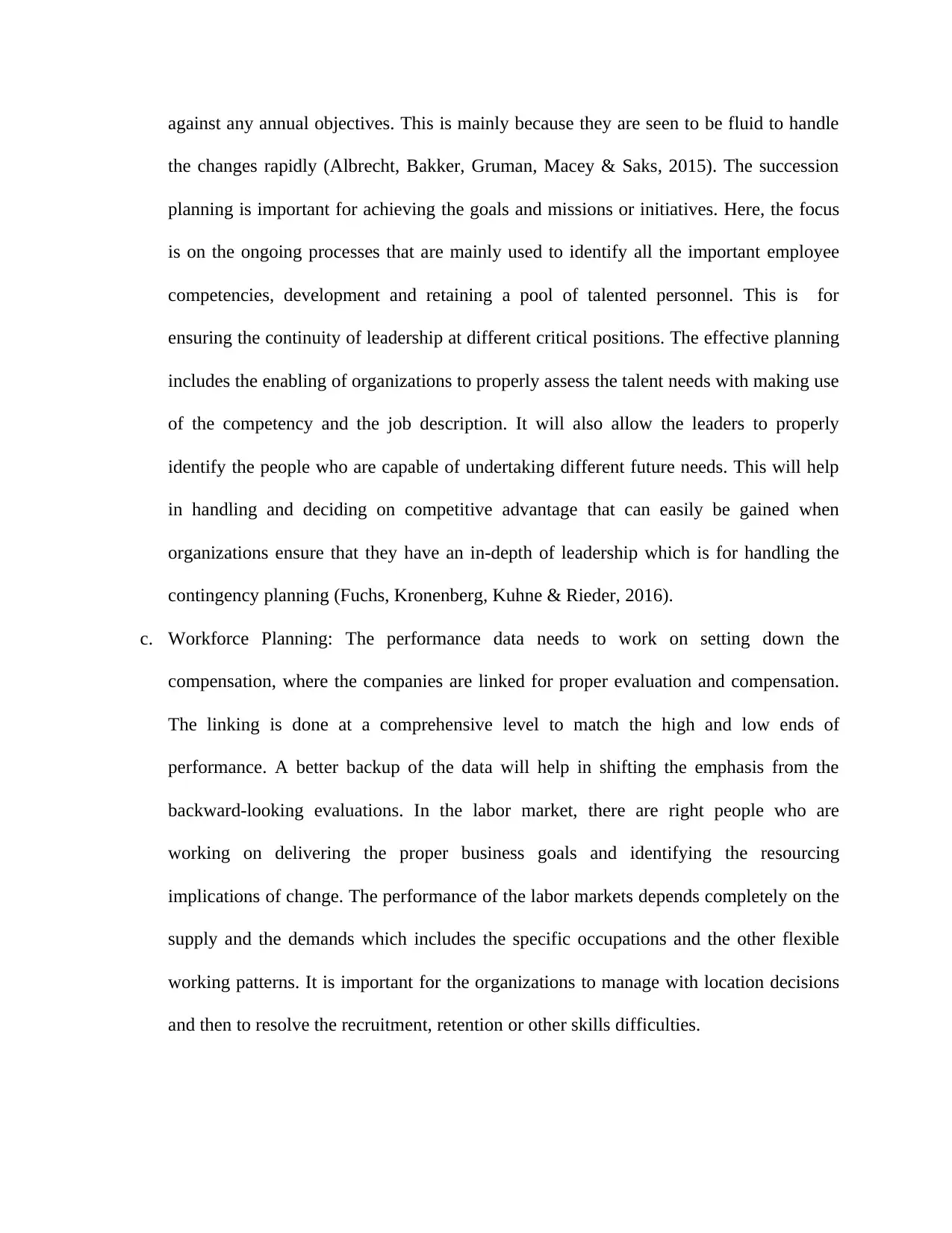
against any annual objectives. This is mainly because they are seen to be fluid to handle
the changes rapidly (Albrecht, Bakker, Gruman, Macey & Saks, 2015). The succession
planning is important for achieving the goals and missions or initiatives. Here, the focus
is on the ongoing processes that are mainly used to identify all the important employee
competencies, development and retaining a pool of talented personnel. This is for
ensuring the continuity of leadership at different critical positions. The effective planning
includes the enabling of organizations to properly assess the talent needs with making use
of the competency and the job description. It will also allow the leaders to properly
identify the people who are capable of undertaking different future needs. This will help
in handling and deciding on competitive advantage that can easily be gained when
organizations ensure that they have an in-depth of leadership which is for handling the
contingency planning (Fuchs, Kronenberg, Kuhne & Rieder, 2016).
c. Workforce Planning: The performance data needs to work on setting down the
compensation, where the companies are linked for proper evaluation and compensation.
The linking is done at a comprehensive level to match the high and low ends of
performance. A better backup of the data will help in shifting the emphasis from the
backward-looking evaluations. In the labor market, there are right people who are
working on delivering the proper business goals and identifying the resourcing
implications of change. The performance of the labor markets depends completely on the
supply and the demands which includes the specific occupations and the other flexible
working patterns. It is important for the organizations to manage with location decisions
and then to resolve the recruitment, retention or other skills difficulties.
the changes rapidly (Albrecht, Bakker, Gruman, Macey & Saks, 2015). The succession
planning is important for achieving the goals and missions or initiatives. Here, the focus
is on the ongoing processes that are mainly used to identify all the important employee
competencies, development and retaining a pool of talented personnel. This is for
ensuring the continuity of leadership at different critical positions. The effective planning
includes the enabling of organizations to properly assess the talent needs with making use
of the competency and the job description. It will also allow the leaders to properly
identify the people who are capable of undertaking different future needs. This will help
in handling and deciding on competitive advantage that can easily be gained when
organizations ensure that they have an in-depth of leadership which is for handling the
contingency planning (Fuchs, Kronenberg, Kuhne & Rieder, 2016).
c. Workforce Planning: The performance data needs to work on setting down the
compensation, where the companies are linked for proper evaluation and compensation.
The linking is done at a comprehensive level to match the high and low ends of
performance. A better backup of the data will help in shifting the emphasis from the
backward-looking evaluations. In the labor market, there are right people who are
working on delivering the proper business goals and identifying the resourcing
implications of change. The performance of the labor markets depends completely on the
supply and the demands which includes the specific occupations and the other flexible
working patterns. It is important for the organizations to manage with location decisions
and then to resolve the recruitment, retention or other skills difficulties.
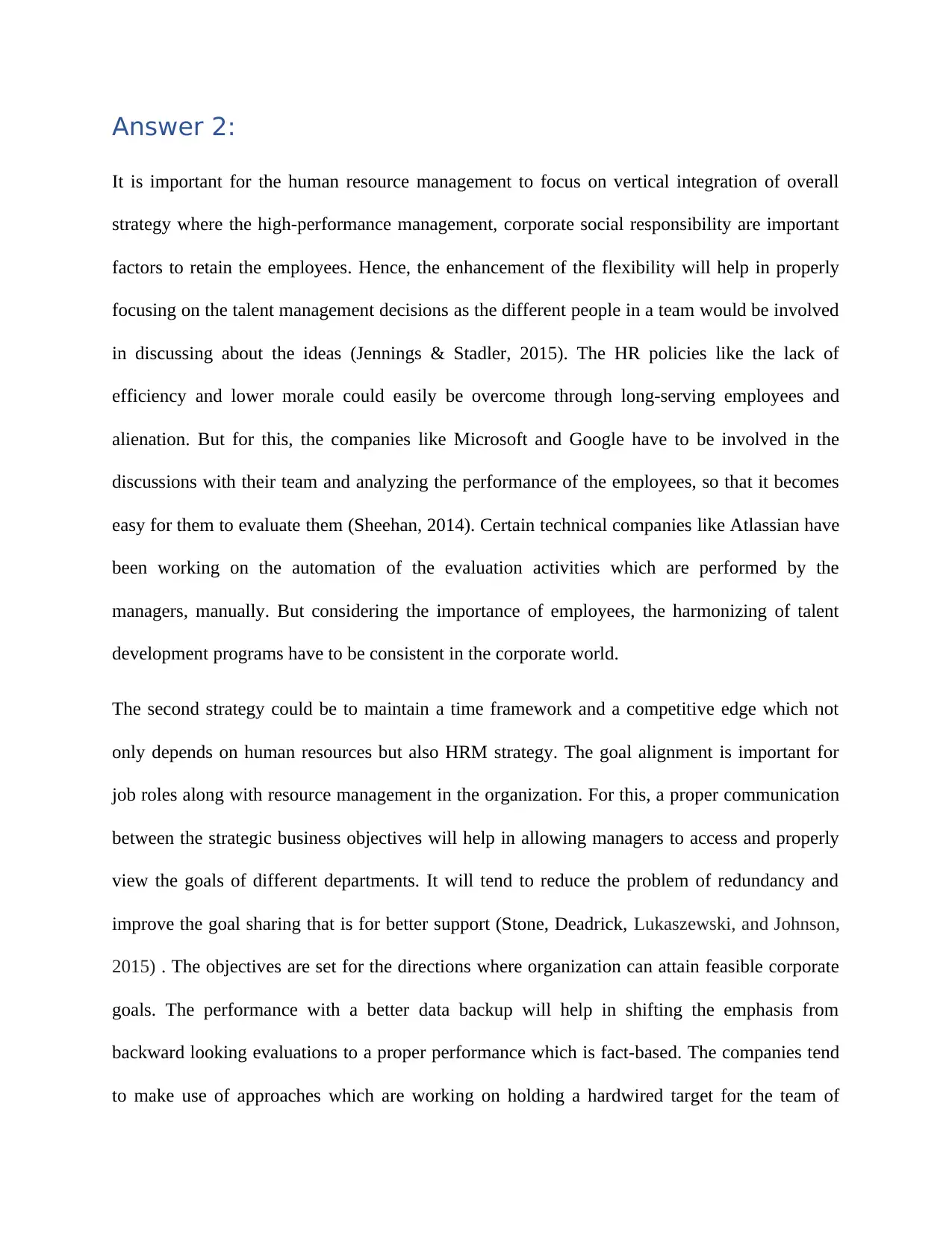
Answer 2:
It is important for the human resource management to focus on vertical integration of overall
strategy where the high-performance management, corporate social responsibility are important
factors to retain the employees. Hence, the enhancement of the flexibility will help in properly
focusing on the talent management decisions as the different people in a team would be involved
in discussing about the ideas (Jennings & Stadler, 2015). The HR policies like the lack of
efficiency and lower morale could easily be overcome through long-serving employees and
alienation. But for this, the companies like Microsoft and Google have to be involved in the
discussions with their team and analyzing the performance of the employees, so that it becomes
easy for them to evaluate them (Sheehan, 2014). Certain technical companies like Atlassian have
been working on the automation of the evaluation activities which are performed by the
managers, manually. But considering the importance of employees, the harmonizing of talent
development programs have to be consistent in the corporate world.
The second strategy could be to maintain a time framework and a competitive edge which not
only depends on human resources but also HRM strategy. The goal alignment is important for
job roles along with resource management in the organization. For this, a proper communication
between the strategic business objectives will help in allowing managers to access and properly
view the goals of different departments. It will tend to reduce the problem of redundancy and
improve the goal sharing that is for better support (Stone, Deadrick, Lukaszewski, and Johnson,
2015) . The objectives are set for the directions where organization can attain feasible corporate
goals. The performance with a better data backup will help in shifting the emphasis from
backward looking evaluations to a proper performance which is fact-based. The companies tend
to make use of approaches which are working on holding a hardwired target for the team of
It is important for the human resource management to focus on vertical integration of overall
strategy where the high-performance management, corporate social responsibility are important
factors to retain the employees. Hence, the enhancement of the flexibility will help in properly
focusing on the talent management decisions as the different people in a team would be involved
in discussing about the ideas (Jennings & Stadler, 2015). The HR policies like the lack of
efficiency and lower morale could easily be overcome through long-serving employees and
alienation. But for this, the companies like Microsoft and Google have to be involved in the
discussions with their team and analyzing the performance of the employees, so that it becomes
easy for them to evaluate them (Sheehan, 2014). Certain technical companies like Atlassian have
been working on the automation of the evaluation activities which are performed by the
managers, manually. But considering the importance of employees, the harmonizing of talent
development programs have to be consistent in the corporate world.
The second strategy could be to maintain a time framework and a competitive edge which not
only depends on human resources but also HRM strategy. The goal alignment is important for
job roles along with resource management in the organization. For this, a proper communication
between the strategic business objectives will help in allowing managers to access and properly
view the goals of different departments. It will tend to reduce the problem of redundancy and
improve the goal sharing that is for better support (Stone, Deadrick, Lukaszewski, and Johnson,
2015) . The objectives are set for the directions where organization can attain feasible corporate
goals. The performance with a better data backup will help in shifting the emphasis from
backward looking evaluations to a proper performance which is fact-based. The companies tend
to make use of approaches which are working on holding a hardwired target for the team of
⊘ This is a preview!⊘
Do you want full access?
Subscribe today to unlock all pages.

Trusted by 1+ million students worldwide
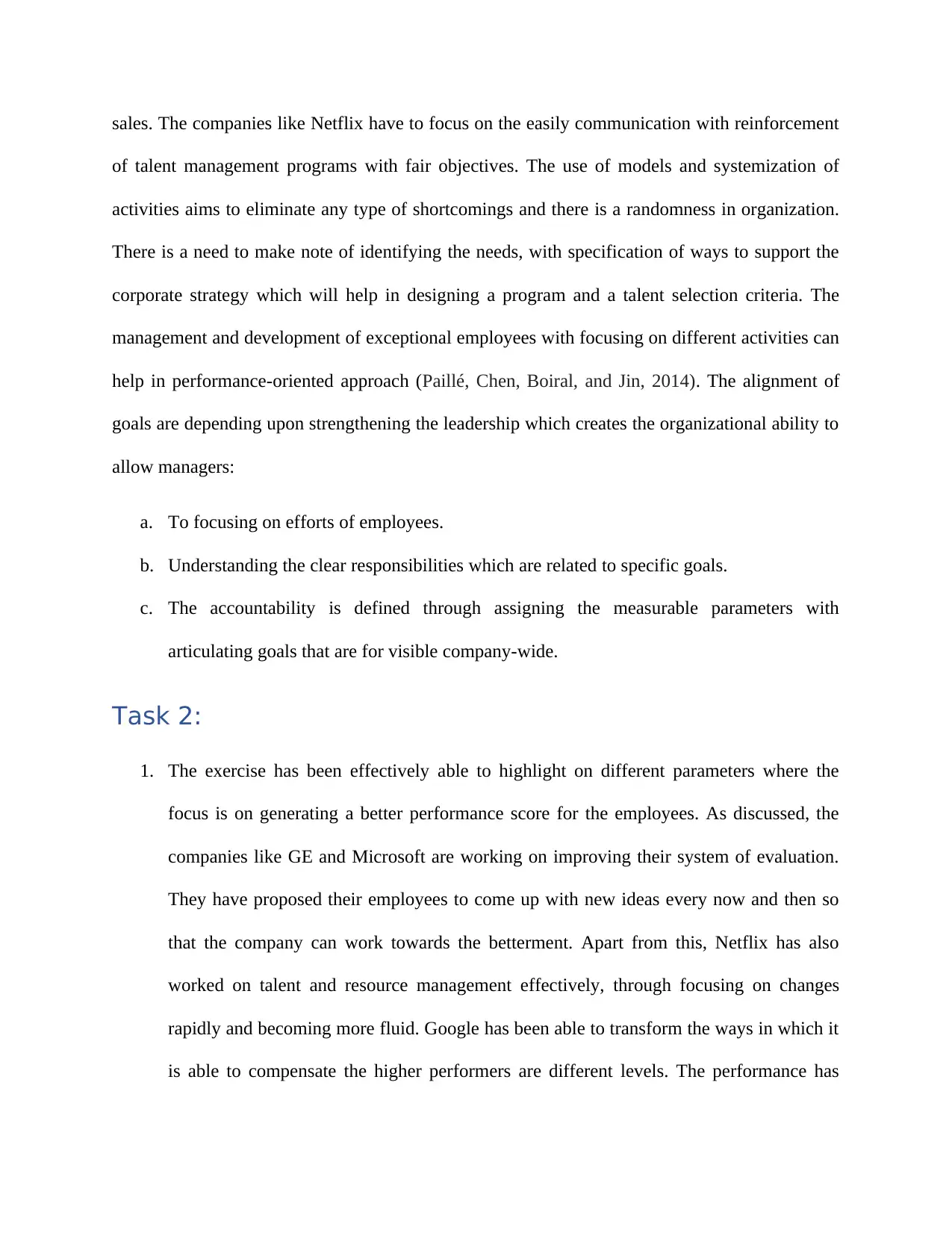
sales. The companies like Netflix have to focus on the easily communication with reinforcement
of talent management programs with fair objectives. The use of models and systemization of
activities aims to eliminate any type of shortcomings and there is a randomness in organization.
There is a need to make note of identifying the needs, with specification of ways to support the
corporate strategy which will help in designing a program and a talent selection criteria. The
management and development of exceptional employees with focusing on different activities can
help in performance-oriented approach (Paillé, Chen, Boiral, and Jin, 2014). The alignment of
goals are depending upon strengthening the leadership which creates the organizational ability to
allow managers:
a. To focusing on efforts of employees.
b. Understanding the clear responsibilities which are related to specific goals.
c. The accountability is defined through assigning the measurable parameters with
articulating goals that are for visible company-wide.
Task 2:
1. The exercise has been effectively able to highlight on different parameters where the
focus is on generating a better performance score for the employees. As discussed, the
companies like GE and Microsoft are working on improving their system of evaluation.
They have proposed their employees to come up with new ideas every now and then so
that the company can work towards the betterment. Apart from this, Netflix has also
worked on talent and resource management effectively, through focusing on changes
rapidly and becoming more fluid. Google has been able to transform the ways in which it
is able to compensate the higher performers are different levels. The performance has
of talent management programs with fair objectives. The use of models and systemization of
activities aims to eliminate any type of shortcomings and there is a randomness in organization.
There is a need to make note of identifying the needs, with specification of ways to support the
corporate strategy which will help in designing a program and a talent selection criteria. The
management and development of exceptional employees with focusing on different activities can
help in performance-oriented approach (Paillé, Chen, Boiral, and Jin, 2014). The alignment of
goals are depending upon strengthening the leadership which creates the organizational ability to
allow managers:
a. To focusing on efforts of employees.
b. Understanding the clear responsibilities which are related to specific goals.
c. The accountability is defined through assigning the measurable parameters with
articulating goals that are for visible company-wide.
Task 2:
1. The exercise has been effectively able to highlight on different parameters where the
focus is on generating a better performance score for the employees. As discussed, the
companies like GE and Microsoft are working on improving their system of evaluation.
They have proposed their employees to come up with new ideas every now and then so
that the company can work towards the betterment. Apart from this, Netflix has also
worked on talent and resource management effectively, through focusing on changes
rapidly and becoming more fluid. Google has been able to transform the ways in which it
is able to compensate the higher performers are different levels. The performance has
Paraphrase This Document
Need a fresh take? Get an instant paraphrase of this document with our AI Paraphraser
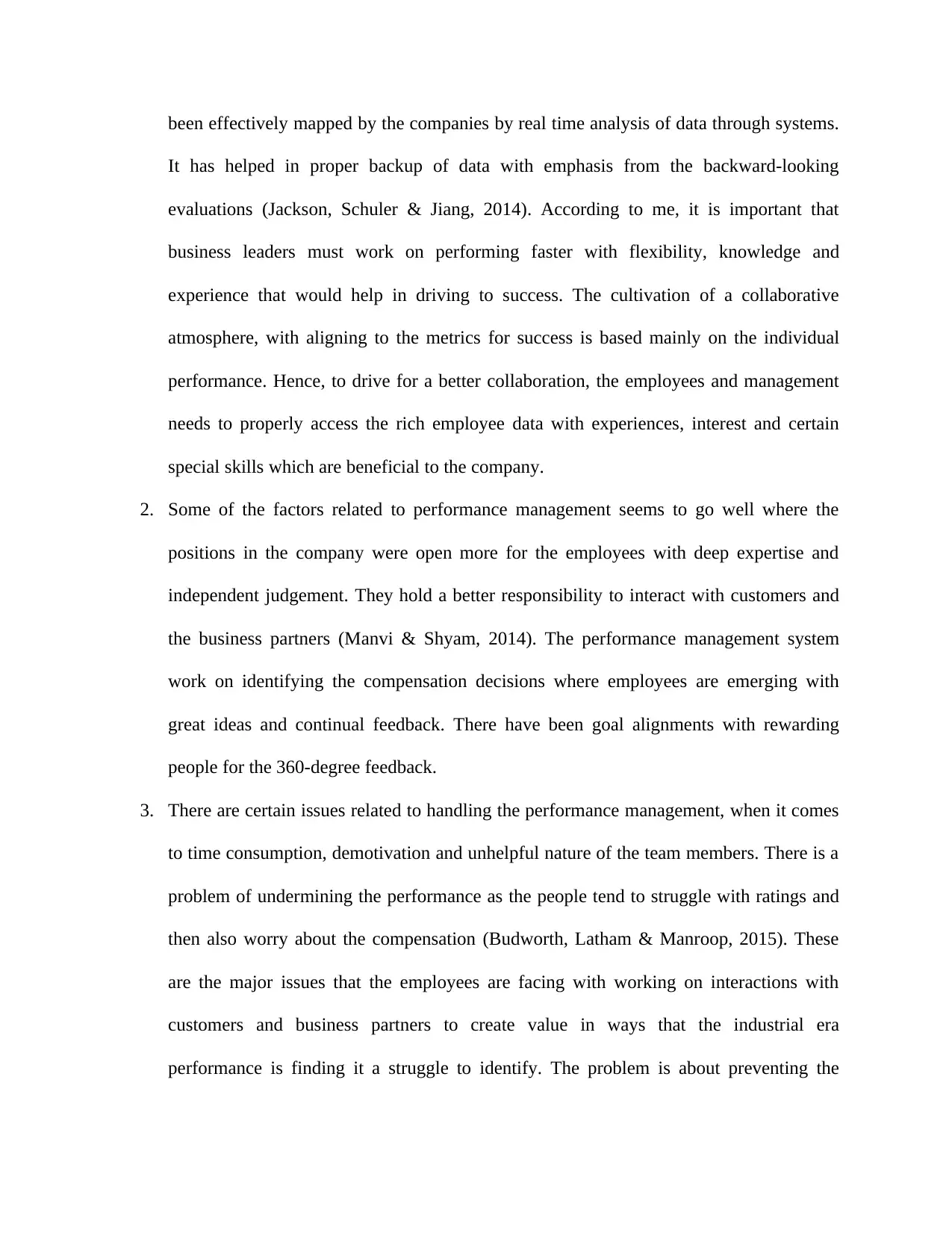
been effectively mapped by the companies by real time analysis of data through systems.
It has helped in proper backup of data with emphasis from the backward-looking
evaluations (Jackson, Schuler & Jiang, 2014). According to me, it is important that
business leaders must work on performing faster with flexibility, knowledge and
experience that would help in driving to success. The cultivation of a collaborative
atmosphere, with aligning to the metrics for success is based mainly on the individual
performance. Hence, to drive for a better collaboration, the employees and management
needs to properly access the rich employee data with experiences, interest and certain
special skills which are beneficial to the company.
2. Some of the factors related to performance management seems to go well where the
positions in the company were open more for the employees with deep expertise and
independent judgement. They hold a better responsibility to interact with customers and
the business partners (Manvi & Shyam, 2014). The performance management system
work on identifying the compensation decisions where employees are emerging with
great ideas and continual feedback. There have been goal alignments with rewarding
people for the 360-degree feedback.
3. There are certain issues related to handling the performance management, when it comes
to time consumption, demotivation and unhelpful nature of the team members. There is a
problem of undermining the performance as the people tend to struggle with ratings and
then also worry about the compensation (Budworth, Latham & Manroop, 2015). These
are the major issues that the employees are facing with working on interactions with
customers and business partners to create value in ways that the industrial era
performance is finding it a struggle to identify. The problem is about preventing the
It has helped in proper backup of data with emphasis from the backward-looking
evaluations (Jackson, Schuler & Jiang, 2014). According to me, it is important that
business leaders must work on performing faster with flexibility, knowledge and
experience that would help in driving to success. The cultivation of a collaborative
atmosphere, with aligning to the metrics for success is based mainly on the individual
performance. Hence, to drive for a better collaboration, the employees and management
needs to properly access the rich employee data with experiences, interest and certain
special skills which are beneficial to the company.
2. Some of the factors related to performance management seems to go well where the
positions in the company were open more for the employees with deep expertise and
independent judgement. They hold a better responsibility to interact with customers and
the business partners (Manvi & Shyam, 2014). The performance management system
work on identifying the compensation decisions where employees are emerging with
great ideas and continual feedback. There have been goal alignments with rewarding
people for the 360-degree feedback.
3. There are certain issues related to handling the performance management, when it comes
to time consumption, demotivation and unhelpful nature of the team members. There is a
problem of undermining the performance as the people tend to struggle with ratings and
then also worry about the compensation (Budworth, Latham & Manroop, 2015). These
are the major issues that the employees are facing with working on interactions with
customers and business partners to create value in ways that the industrial era
performance is finding it a struggle to identify. The problem is about preventing the
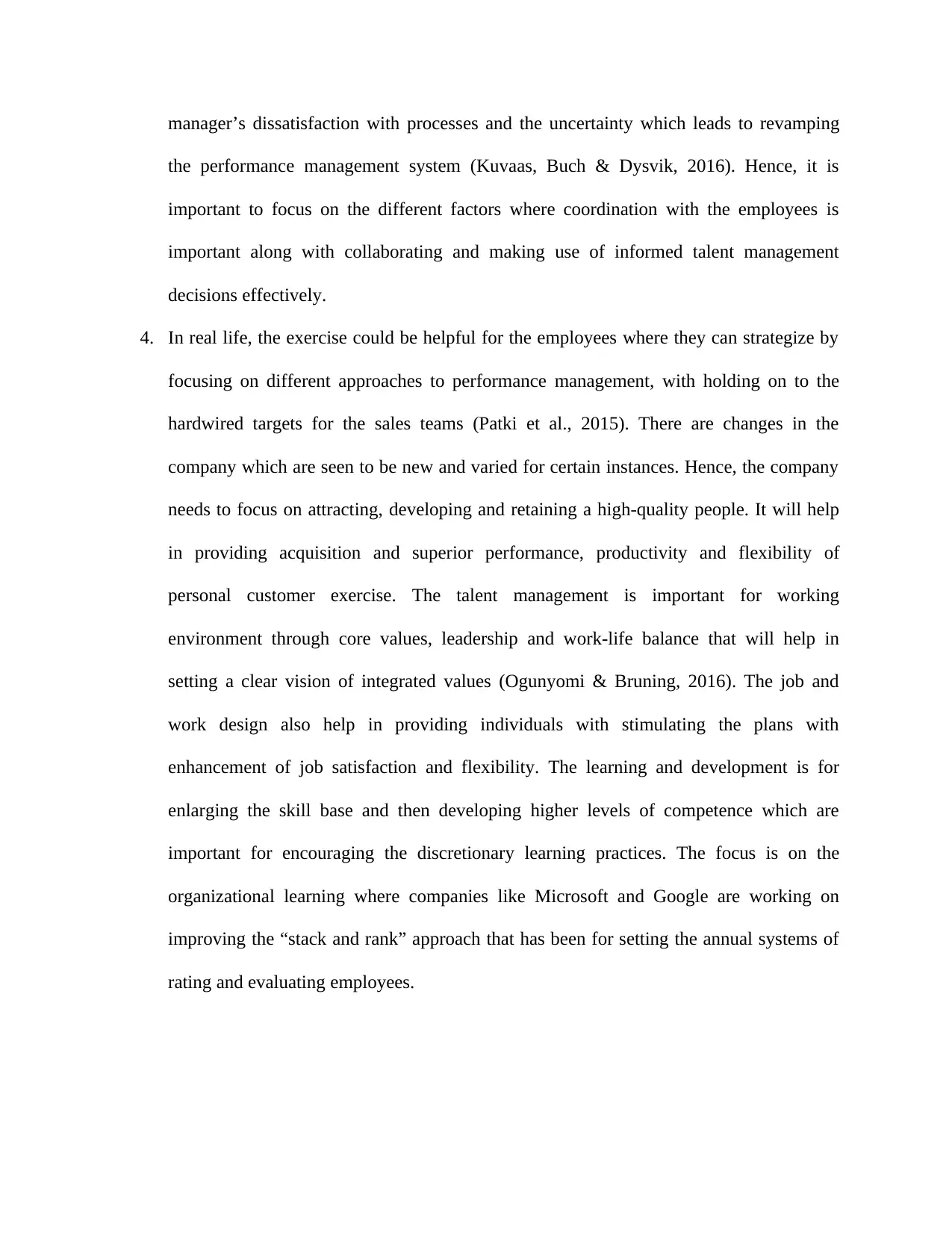
manager’s dissatisfaction with processes and the uncertainty which leads to revamping
the performance management system (Kuvaas, Buch & Dysvik, 2016). Hence, it is
important to focus on the different factors where coordination with the employees is
important along with collaborating and making use of informed talent management
decisions effectively.
4. In real life, the exercise could be helpful for the employees where they can strategize by
focusing on different approaches to performance management, with holding on to the
hardwired targets for the sales teams (Patki et al., 2015). There are changes in the
company which are seen to be new and varied for certain instances. Hence, the company
needs to focus on attracting, developing and retaining a high-quality people. It will help
in providing acquisition and superior performance, productivity and flexibility of
personal customer exercise. The talent management is important for working
environment through core values, leadership and work-life balance that will help in
setting a clear vision of integrated values (Ogunyomi & Bruning, 2016). The job and
work design also help in providing individuals with stimulating the plans with
enhancement of job satisfaction and flexibility. The learning and development is for
enlarging the skill base and then developing higher levels of competence which are
important for encouraging the discretionary learning practices. The focus is on the
organizational learning where companies like Microsoft and Google are working on
improving the “stack and rank” approach that has been for setting the annual systems of
rating and evaluating employees.
the performance management system (Kuvaas, Buch & Dysvik, 2016). Hence, it is
important to focus on the different factors where coordination with the employees is
important along with collaborating and making use of informed talent management
decisions effectively.
4. In real life, the exercise could be helpful for the employees where they can strategize by
focusing on different approaches to performance management, with holding on to the
hardwired targets for the sales teams (Patki et al., 2015). There are changes in the
company which are seen to be new and varied for certain instances. Hence, the company
needs to focus on attracting, developing and retaining a high-quality people. It will help
in providing acquisition and superior performance, productivity and flexibility of
personal customer exercise. The talent management is important for working
environment through core values, leadership and work-life balance that will help in
setting a clear vision of integrated values (Ogunyomi & Bruning, 2016). The job and
work design also help in providing individuals with stimulating the plans with
enhancement of job satisfaction and flexibility. The learning and development is for
enlarging the skill base and then developing higher levels of competence which are
important for encouraging the discretionary learning practices. The focus is on the
organizational learning where companies like Microsoft and Google are working on
improving the “stack and rank” approach that has been for setting the annual systems of
rating and evaluating employees.
⊘ This is a preview!⊘
Do you want full access?
Subscribe today to unlock all pages.

Trusted by 1+ million students worldwide
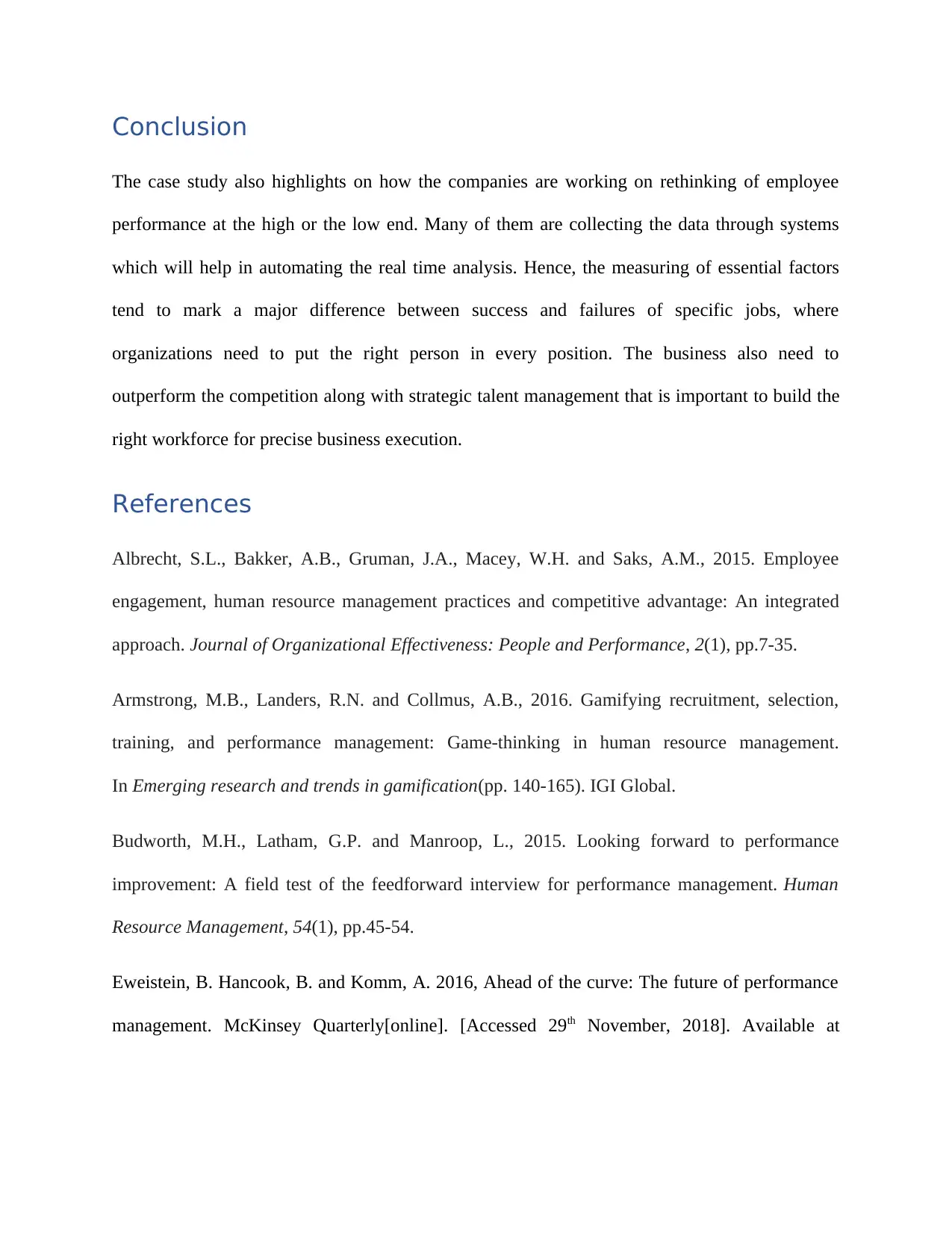
Conclusion
The case study also highlights on how the companies are working on rethinking of employee
performance at the high or the low end. Many of them are collecting the data through systems
which will help in automating the real time analysis. Hence, the measuring of essential factors
tend to mark a major difference between success and failures of specific jobs, where
organizations need to put the right person in every position. The business also need to
outperform the competition along with strategic talent management that is important to build the
right workforce for precise business execution.
References
Albrecht, S.L., Bakker, A.B., Gruman, J.A., Macey, W.H. and Saks, A.M., 2015. Employee
engagement, human resource management practices and competitive advantage: An integrated
approach. Journal of Organizational Effectiveness: People and Performance, 2(1), pp.7-35.
Armstrong, M.B., Landers, R.N. and Collmus, A.B., 2016. Gamifying recruitment, selection,
training, and performance management: Game-thinking in human resource management.
In Emerging research and trends in gamification(pp. 140-165). IGI Global.
Budworth, M.H., Latham, G.P. and Manroop, L., 2015. Looking forward to performance
improvement: A field test of the feedforward interview for performance management. Human
Resource Management, 54(1), pp.45-54.
Eweistein, B. Hancook, B. and Komm, A. 2016, Ahead of the curve: The future of performance
management. McKinsey Quarterly[online]. [Accessed 29th November, 2018]. Available at
The case study also highlights on how the companies are working on rethinking of employee
performance at the high or the low end. Many of them are collecting the data through systems
which will help in automating the real time analysis. Hence, the measuring of essential factors
tend to mark a major difference between success and failures of specific jobs, where
organizations need to put the right person in every position. The business also need to
outperform the competition along with strategic talent management that is important to build the
right workforce for precise business execution.
References
Albrecht, S.L., Bakker, A.B., Gruman, J.A., Macey, W.H. and Saks, A.M., 2015. Employee
engagement, human resource management practices and competitive advantage: An integrated
approach. Journal of Organizational Effectiveness: People and Performance, 2(1), pp.7-35.
Armstrong, M.B., Landers, R.N. and Collmus, A.B., 2016. Gamifying recruitment, selection,
training, and performance management: Game-thinking in human resource management.
In Emerging research and trends in gamification(pp. 140-165). IGI Global.
Budworth, M.H., Latham, G.P. and Manroop, L., 2015. Looking forward to performance
improvement: A field test of the feedforward interview for performance management. Human
Resource Management, 54(1), pp.45-54.
Eweistein, B. Hancook, B. and Komm, A. 2016, Ahead of the curve: The future of performance
management. McKinsey Quarterly[online]. [Accessed 29th November, 2018]. Available at
Paraphrase This Document
Need a fresh take? Get an instant paraphrase of this document with our AI Paraphraser
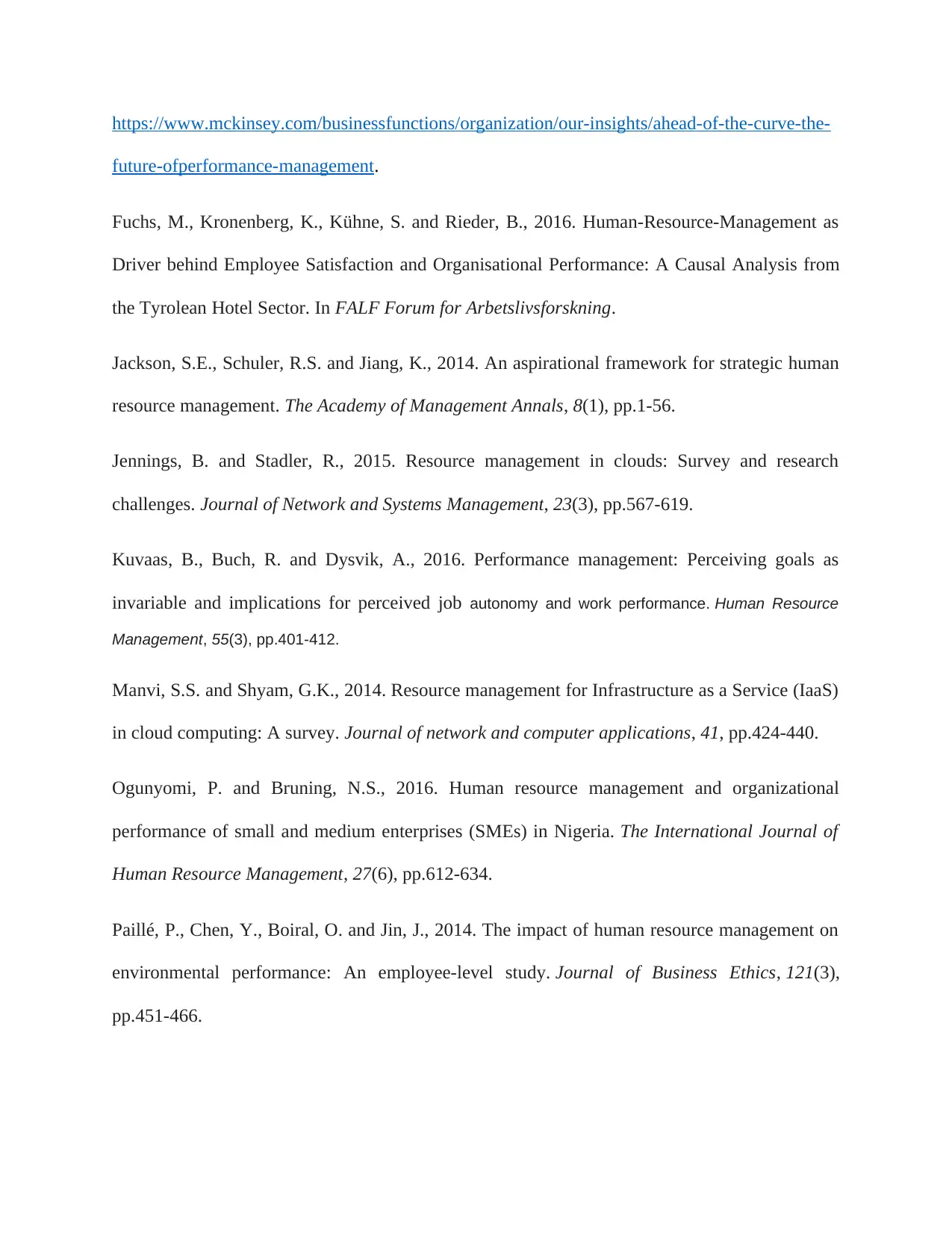
https://www.mckinsey.com/businessfunctions/organization/our-insights/ahead-of-the-curve-the-
future-ofperformance-management.
Fuchs, M., Kronenberg, K., Kühne, S. and Rieder, B., 2016. Human-Resource-Management as
Driver behind Employee Satisfaction and Organisational Performance: A Causal Analysis from
the Tyrolean Hotel Sector. In FALF Forum for Arbetslivsforskning.
Jackson, S.E., Schuler, R.S. and Jiang, K., 2014. An aspirational framework for strategic human
resource management. The Academy of Management Annals, 8(1), pp.1-56.
Jennings, B. and Stadler, R., 2015. Resource management in clouds: Survey and research
challenges. Journal of Network and Systems Management, 23(3), pp.567-619.
Kuvaas, B., Buch, R. and Dysvik, A., 2016. Performance management: Perceiving goals as
invariable and implications for perceived job autonomy and work performance. Human Resource
Management, 55(3), pp.401-412.
Manvi, S.S. and Shyam, G.K., 2014. Resource management for Infrastructure as a Service (IaaS)
in cloud computing: A survey. Journal of network and computer applications, 41, pp.424-440.
Ogunyomi, P. and Bruning, N.S., 2016. Human resource management and organizational
performance of small and medium enterprises (SMEs) in Nigeria. The International Journal of
Human Resource Management, 27(6), pp.612-634.
Paillé, P., Chen, Y., Boiral, O. and Jin, J., 2014. The impact of human resource management on
environmental performance: An employee-level study. Journal of Business Ethics, 121(3),
pp.451-466.
future-ofperformance-management.
Fuchs, M., Kronenberg, K., Kühne, S. and Rieder, B., 2016. Human-Resource-Management as
Driver behind Employee Satisfaction and Organisational Performance: A Causal Analysis from
the Tyrolean Hotel Sector. In FALF Forum for Arbetslivsforskning.
Jackson, S.E., Schuler, R.S. and Jiang, K., 2014. An aspirational framework for strategic human
resource management. The Academy of Management Annals, 8(1), pp.1-56.
Jennings, B. and Stadler, R., 2015. Resource management in clouds: Survey and research
challenges. Journal of Network and Systems Management, 23(3), pp.567-619.
Kuvaas, B., Buch, R. and Dysvik, A., 2016. Performance management: Perceiving goals as
invariable and implications for perceived job autonomy and work performance. Human Resource
Management, 55(3), pp.401-412.
Manvi, S.S. and Shyam, G.K., 2014. Resource management for Infrastructure as a Service (IaaS)
in cloud computing: A survey. Journal of network and computer applications, 41, pp.424-440.
Ogunyomi, P. and Bruning, N.S., 2016. Human resource management and organizational
performance of small and medium enterprises (SMEs) in Nigeria. The International Journal of
Human Resource Management, 27(6), pp.612-634.
Paillé, P., Chen, Y., Boiral, O. and Jin, J., 2014. The impact of human resource management on
environmental performance: An employee-level study. Journal of Business Ethics, 121(3),
pp.451-466.
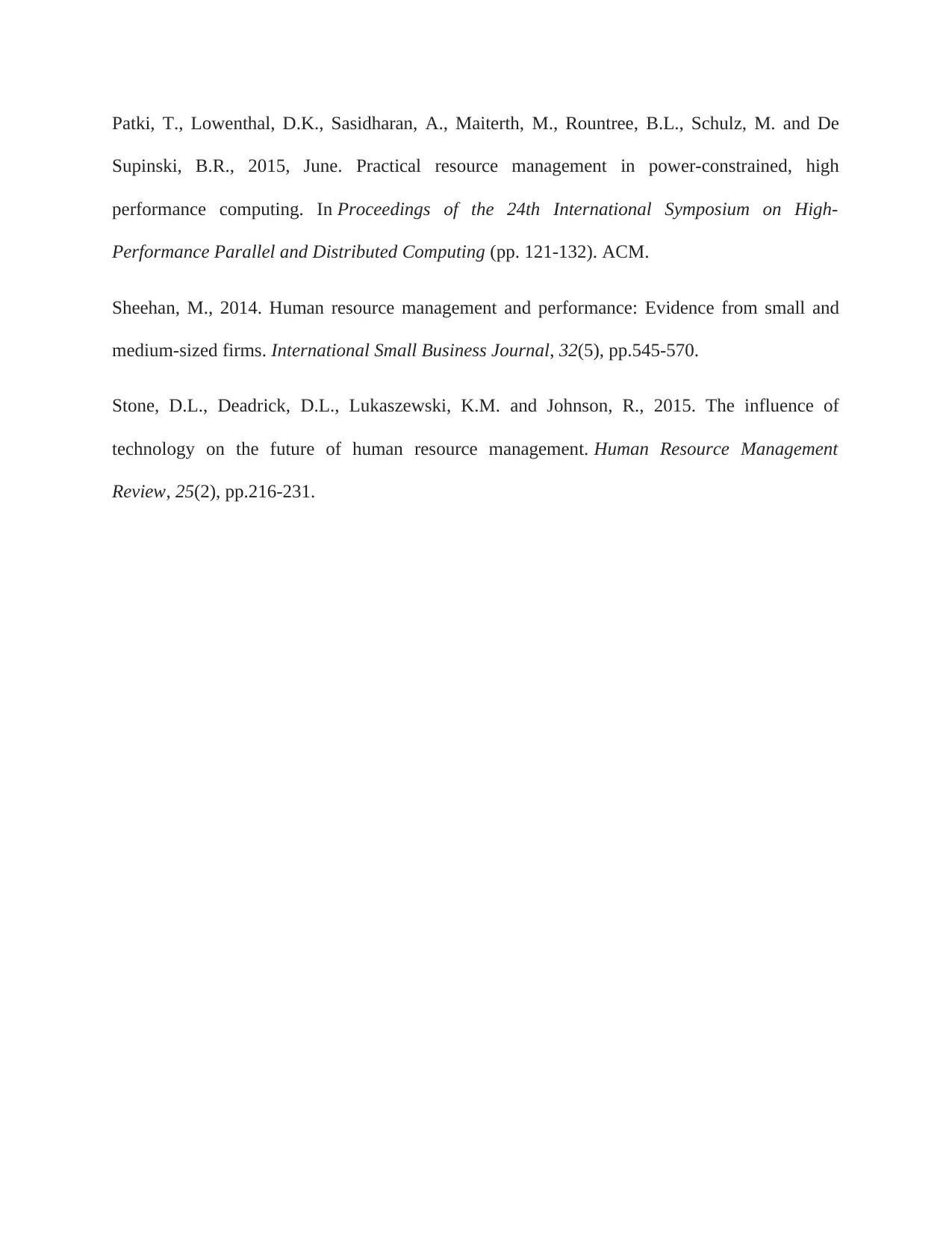
Patki, T., Lowenthal, D.K., Sasidharan, A., Maiterth, M., Rountree, B.L., Schulz, M. and De
Supinski, B.R., 2015, June. Practical resource management in power-constrained, high
performance computing. In Proceedings of the 24th International Symposium on High-
Performance Parallel and Distributed Computing (pp. 121-132). ACM.
Sheehan, M., 2014. Human resource management and performance: Evidence from small and
medium-sized firms. International Small Business Journal, 32(5), pp.545-570.
Stone, D.L., Deadrick, D.L., Lukaszewski, K.M. and Johnson, R., 2015. The influence of
technology on the future of human resource management. Human Resource Management
Review, 25(2), pp.216-231.
Supinski, B.R., 2015, June. Practical resource management in power-constrained, high
performance computing. In Proceedings of the 24th International Symposium on High-
Performance Parallel and Distributed Computing (pp. 121-132). ACM.
Sheehan, M., 2014. Human resource management and performance: Evidence from small and
medium-sized firms. International Small Business Journal, 32(5), pp.545-570.
Stone, D.L., Deadrick, D.L., Lukaszewski, K.M. and Johnson, R., 2015. The influence of
technology on the future of human resource management. Human Resource Management
Review, 25(2), pp.216-231.
⊘ This is a preview!⊘
Do you want full access?
Subscribe today to unlock all pages.

Trusted by 1+ million students worldwide
1 out of 12
Related Documents
Your All-in-One AI-Powered Toolkit for Academic Success.
+13062052269
info@desklib.com
Available 24*7 on WhatsApp / Email
![[object Object]](/_next/static/media/star-bottom.7253800d.svg)
Unlock your academic potential
Copyright © 2020–2025 A2Z Services. All Rights Reserved. Developed and managed by ZUCOL.




